Interior designers make spaces beautiful and useful. They choose colors, furniture, and decorations to make rooms look good and work well. Interior designers help people feel happy and comfortable in their homes, offices, and other places. This article will explain the job description for an interior designer, including their main responsibilities and the skills they need.
What is an Interior Designer?
An interior designer is a professional who makes spaces look good and work well. They think about colors, furniture, and decorations to create beautiful rooms. Interior designers plan how a space will look and make sure it is useful.
Benefits of Becoming an Interior Designer
- Creativity:Interior designers get to use their Creativity in design every day. They think of new ideas and find ways to make spaces look great.
- Helping Others:Interior designers help people by making their homes and workplaces better. This can make clients very happy.
- Variety:Every project is different. Interior designers work on many types of spaces, from homes to offices to hotels.
- Flexibility:Many interior designers can choose their hours. They might work for a company or start their own business.
- Job Growth:The demand for interior designers is growing. More people want their homes and workplaces to look good and be functional.
- Good Income:Interior designers can earn a good income, especially as they gain more experience. They might start as assistants and work their way up to senior designers or start their own companies.
- Lifelong Learning:Interior designers always learn new things. They keep up with new trends and technologies. This lifelong learning keeps the job interesting and helps designers stay at the top of their field.
- Making a Difference:Interior designers can make a big difference in people’s lives. They create spaces that improve how people feel and function.
Becoming an interior designer has many benefits. It is a creative and fulfilling career with many opportunities for growth and success.
Main Responsibilities of an Interior Designer
Creating Design Concepts
Interior designers start by thinking of ideas for how a room should look. They imagine different colors, furniture, and decorations that would make the space beautiful and practical. They might draw pictures or use computer programs to show their ideas.
Selecting Materials and Furnishings
Once they have a design idea, interior designers choose the materials and furnishings to bring the idea to life.They make sure everything matches and looks good together.
Working with Clients to Meet Their Needs
Interior designers talk a lot with their clients. They ask questions to understand what the clients want and need in their space. They listen carefully to the clients’ likes and dislikes.
Managing Project Timelines and Budgets
Interior designers also keep track of time and money for their projects. They make schedules to ensure that everything gets done on time. They also keep an eye on the budget, making sure they do not spend too much money. This is important to avoid any surprises for the clients.
Ensuring Designs Meet Safety Standards
Safety is very important in interior design. Interior designers make sure that their designs follow all the safety rules. They check that their designs meet building codes and other regulations.
Supervising Installation of Design Elements
After planning and choosing materials, interior designers oversee the installation of their designs.
Updating Clients on Progress
Interior designers regularly update their clients about how the project is going. They let them know if things are on schedule or if there are any delays.
Staying Within Budget
Interior designers are careful with money. They find ways to save money without making the design look cheap. They keep track of expenses and make sure they do not go over the budget.
Researching New Trends
Interior designers always look for new ideas and trends. They read magazines, visit design shows, and take classes to learn about the latest styles and techniques.
Communicating with Vendors
Interior designers talk with vendors who sell furniture, fabrics, and other design materials. They negotiate prices and make sure that the materials arrive on time.
What Qualifications Are Required to Become an Interior Designer?
Education
Most people start by going to college or a university. They learn about design, color schemes, space planning, and other important topics. Some schools offer special programs just for interior design.
Certification and Licensing
This means they have to pass tests to show they know the rules and standards of design. Certification helps show that an interior designer is qualified and has the right skills.
Experience
Many people start by working as interns or assistants. They help more experienced designers and learn on the job.
Continuing Education
They need to keep learning even after they start working. They take continuing education classes to stay updated on new trends and techniques.
Portfolio
A good portfolio is important for an interior designer. A portfolio is a collection of a designer’s best work. It shows their style and skills.
Essential Skills for Interior Designers
Creativity
Creativity is a key qualifications for interior designers. Creativity helps designers solve problems and make their designs unique.
Technical Skills
They use special design software tools to create their designs. Programs like AutoCAD, SketchUp, and Revit help designers make detailed drawings and plans.
Communication Skills
Interior designers need to talk to clients, builders, and vendors. They must be able to explain their ideas clearly and listen to what others need.
Attention to Detail
They need to make sure that everything in their design works well together. Small details like the color of a pillow or the placement of a lamp can make a big difference.
Problem-Solving Skills
Designers often face challenges and need strong problem-solving skills. They might need to work around a difficult space or find a way to stay within a budget.
Client Collaboration
Interior designers work closely with clients to create spaces they love. Here’s how they do it:
Listening to Clients
The first step is listening to what clients like and need. Interior designers ask questions and pay close attention to the answers. Understanding the client’s style and preferences helps designers create a space that fits their vision.
Showing Ideas
Once they understand what the client wants, interior designers show their ideas. They use drawings, samples, and mood boards to give clients a clear picture of the design.
Making Changes
Designers are always open to client feedback. If a client doesn’t like something, the designer will make changes. This might mean picking a different colour, changing a piece of furniture, or adjusting the layout.
Building Relationships
Building a good relationship with clients is very important. Designers who are friendly, professional, and easy to work with are more likely to have happy clients.
Tools and Software
Interior designers use many tools and software to create their designs. These tools help them make detailed plans and show clients what the finished space will look like.
Design Software
Programs like AutoCAD, SketchUp, and Revit are essential for interior designers. These programs help designers create detailed drawings and 3D models of their designs.
Visualization Tools
Visualization tools help clients see what the finished space will look like. These tools can create realistic images or virtual tours of the design.
Project Management Software
Interior designers use project management software to keep track of their projects. This software helps them manage time, budgets, and interior design tasks.
Types of Projects
Homes
Interior designers often work on homes. They make homes cozy and stylish by choosing colors, furniture arrangement, and decorations that make the house feel warm and inviting.
Offices and Workplaces
Other types of projects are offices and workplaces. Designers create spaces where people can work comfortably and efficiently. They pick furniture that is both functional and attractive. They make sure there are enough places to store things and that the layout helps people do their jobs well.
Hotels and Restaurants
Interior designers also work in hotels and restaurants. For hotels, they create rooms that are comfortable and luxurious. They choose furniture and decorations that make guests feel relaxed and pampered. For restaurants, they design spaces that are inviting and fit the style of the food.
Stores
Stores are another common project for interior designers. They create layouts that make it easy for customers to shop and choose displays and decorations that showcase the products well.
Public Spaces
Sometimes, interior designers work in public spaces like libraries, museums, and airports.
The Importance of Creativity
Unique Ideas
Creativity is essential for interior designers. This means thinking of new ways to use colours, furniture, and decorations. Unique ideas help make each project special and different from others.
Good Looks and Practical Use
Designs must look good and be practical. A creative designer ensures that a space is beautiful and works well. For example, a living room should be stylish and comfortable.
Innovation
Being innovative means finding new and better ways to do things. Interior designers use creativity to solve problems and make improvements. For example, they might find a new way to save space in a small room or devise a creative storage solution.
Standing Out
Creativity helps designers stand out in their field. Clients want designs that are fresh and exciting. A creative designer can offer something new that others might not think of.
Success
In the world of interior design, being creative is a big part of success. Creative designers are more likely to be noticed and remembered. Their unique and innovative designs attract clients and help them build a strong reputation.
Interior Designer Salary
Salary Estimates
The salary for an interior designer can vary a lot. Here are some examples:
- Indeed says interior designers in the United States make between ,000 and 0,000 per year.
- ZipRecruiter reports that interior designers in Illinois make between ,000 and ,000 per year.
- Salary.com shows that an entry-level interior designer (Interior Designer I) in the United States makes between ,000 and ,000 per year.
Staying Updated with Industry Trends
Attending Workshops and Conferences
Interior designers stay updated by going to workshops and conferences. These events teach them about the latest design trends and new ideas in design. Conferences have talks from experts who share their knowledge.
Reading Design Magazines and Blogs
Reading design magazines and blogs is another way interior designers keep up with trends. Magazines have lots of pictures and articles about the newest styles and ideas.
Networking with Other Professionals
Interior designers also network with other professionals to learn and share ideas. Networking means meeting and talking to other people in the design world. Designers can join professional groups or go to industry events to meet others.
Following Social Media
Many interior designers use social media to stay updated with industry trends. Platforms like Instagram, Pinterest, and LinkedIn are popular among designers.
Taking Online Courses
Online courses are a flexible way for interior designers to learn new skills and stay current.
Visiting Showrooms and Exhibits
Interior designers often visit showrooms and exhibits to see new products and designs in person. Showrooms display the latest furniture, lighting, and decor items.
Joining Professional Associations
Being part of a professional association helps interior designers stay updated. Some well-known associations for interior designers include the American Society of Interior Designers (ASID) and the International Interior Design Association (IIDA).
Sample Job Description for an Interior Designer
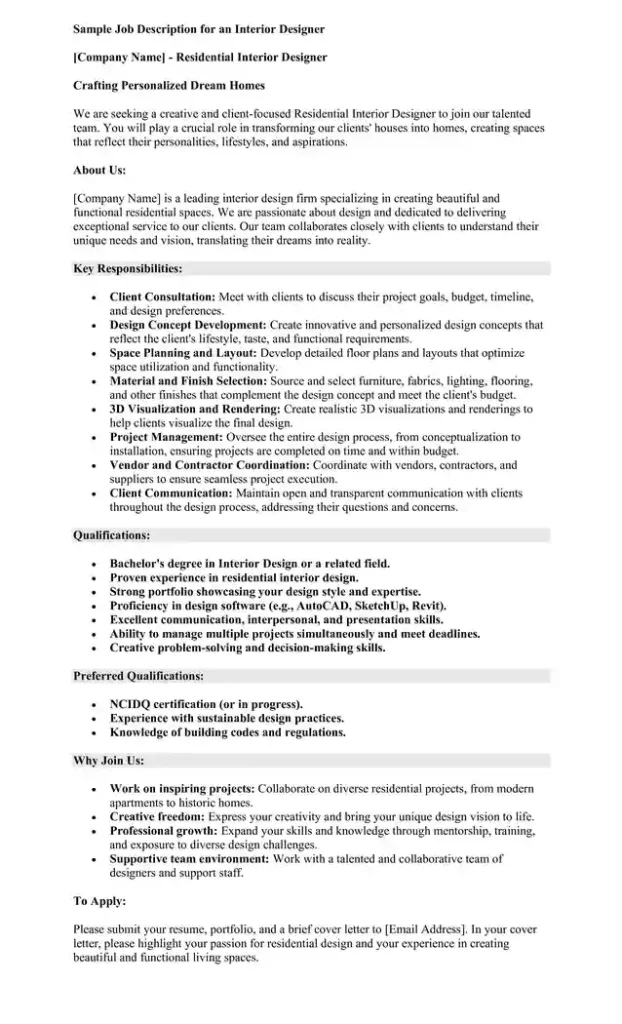
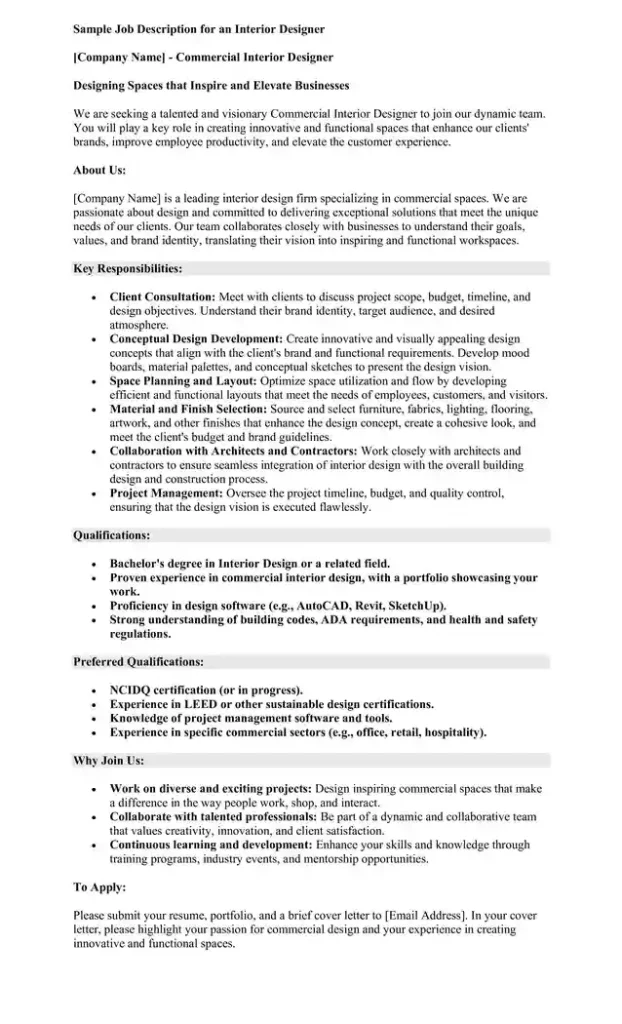
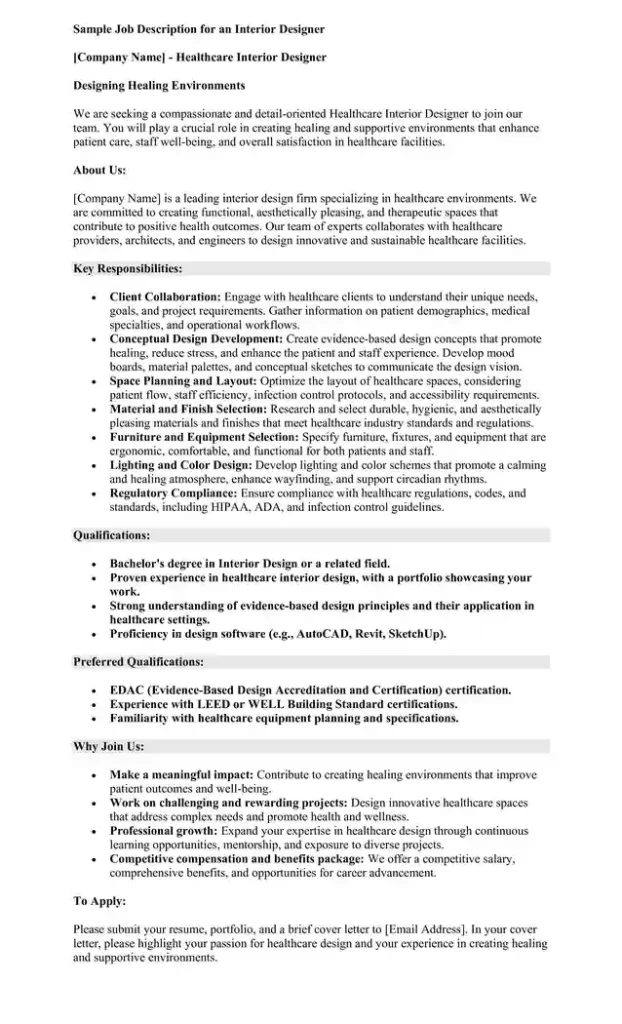
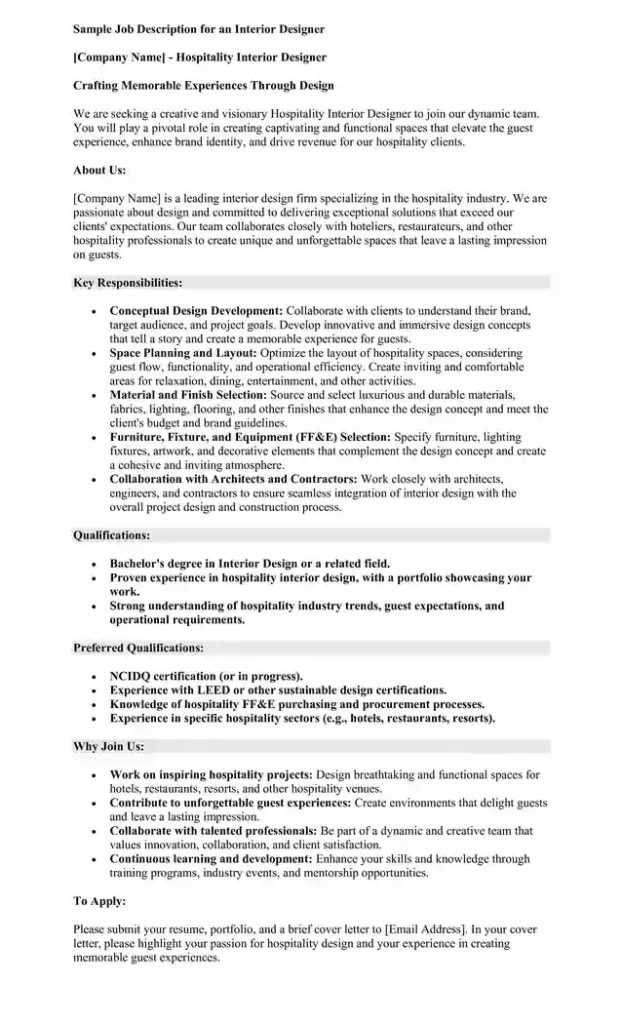
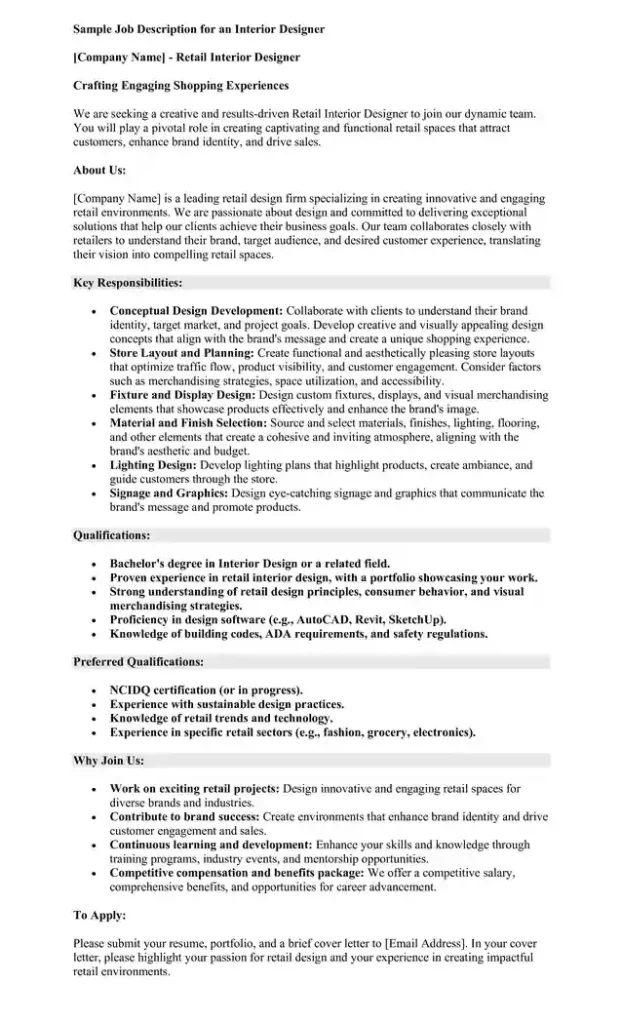
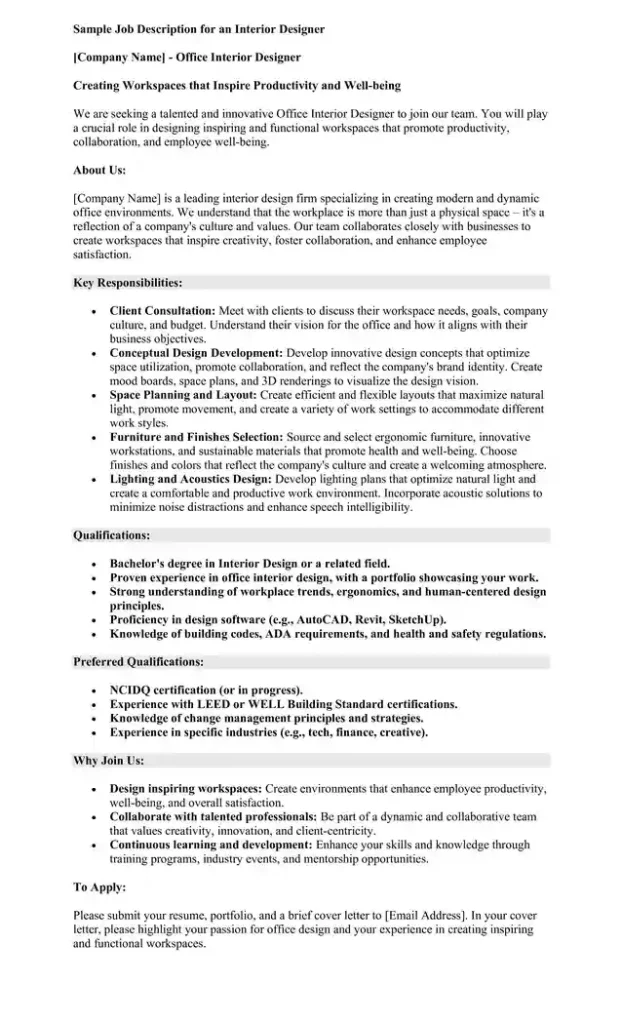
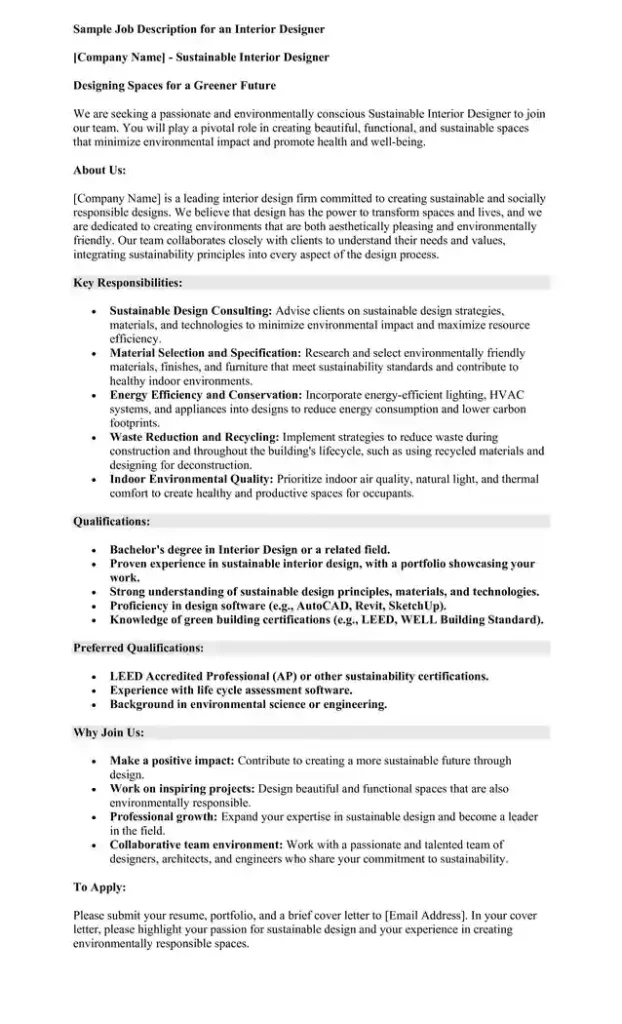
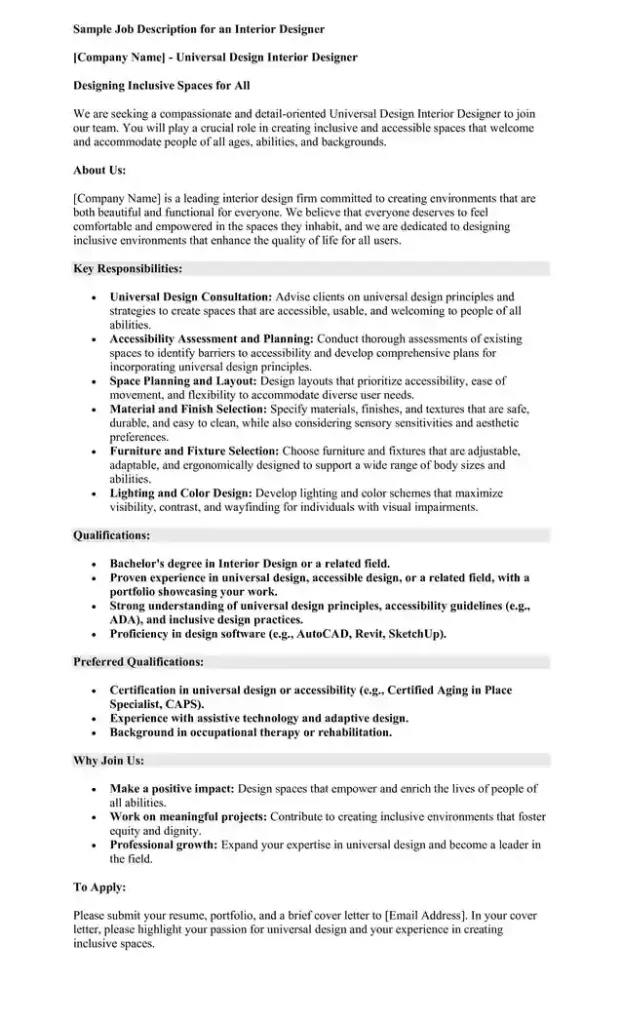
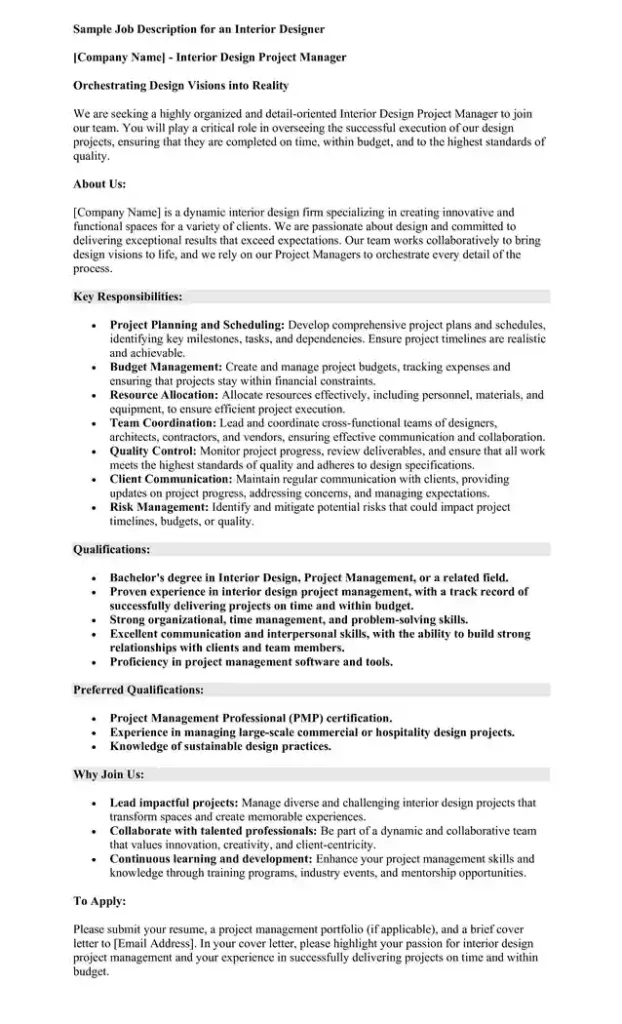
Career Path for an Interior Designer
Starting as an Assistant
Most interior designers start as assistants. They help experienced designers and learn on the job. Assistants create drawings, choose materials, and meet with clients.
Gaining Experience
Next, they become junior designers. They take on more responsibilities and work on their own projects with guidance from senior designers.
Becoming a Senior Designer
With more experience, they become senior designers. Senior designers lead projects, manage teams, and work directly with clients.
Specializing in a Niche
Some designers specialize in areas like residential, commercial, or sustainable design. Specializing helps them become experts in their field.
Starting a Business
Many designers start their own firms. This gives them control over projects and business decisions. They need design skills and knowledge of marketing, finance, and management.
Continuing Education
Designers keep learning through classes, workshops, and reading. This helps them stay updated on trends and new skills.
Networking
Joining professional groups like ASID helps designers advance their careers. These groups offer resources, networking, and certifications.
Gaining Certification
In many places, designers need certification or licensing. This shows they know design principles and building codes.
Reaching the Top
Successful designers might get featured in magazines, win awards, or work on high-profile projects. Success comes from creativity, business skills, and good relationships.
Conclusion
The job description for an interior designer includes making spaces both beautiful and functional. They have many interior design responsibilities and need a variety of skills. With the proper education and creativity, they can have a rewarding career. Interior designers help create spaces that make people happy and comfortable.

Alexander is a skilled HR expert who writes clear and compelling job descriptions. He has spent over 15 years in the HR field, helping companies find and keep the best employees. With a degree in Human Resources Management from the University of Chicago, he has the knowledge to back up his experience.








